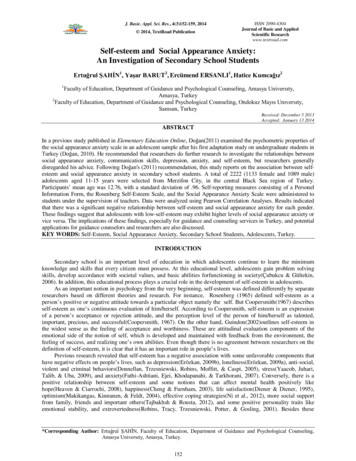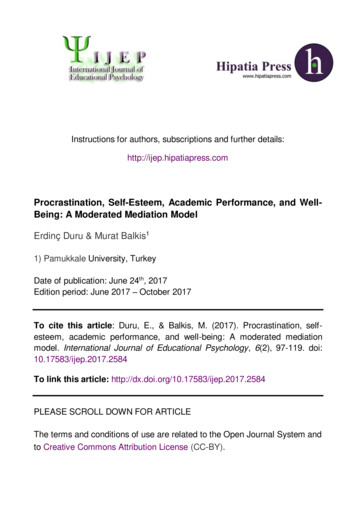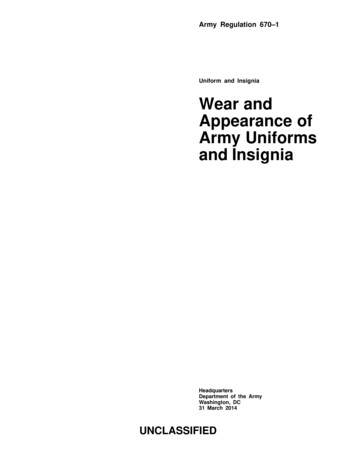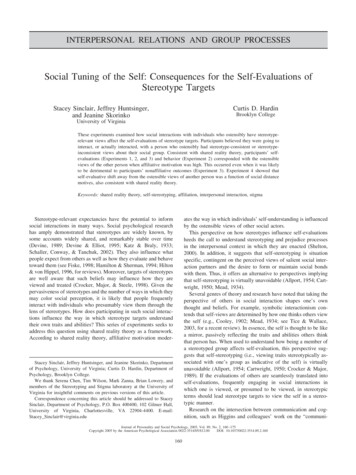
Transcription
J. Basic. Appl. Sci. Res., 4(3)152-159, 2014 2014, TextRoad PublicationISSN 2090-4304Journal of Basic and AppliedScientific Researchwww.textroad.comSelf-esteem and Social Appearance Anxiety:An Investigation of Secondary School StudentsErtuğrul ŞAHİN1, Yaşar BARUT2, Ercümend ERSANLI1, Hatice Kumcağız21Faculty of Education, Department of Guidance and Psychological Counseling, Amasya Universıty,Amasya, Turkey2Faculty of Education, Department of Guidance and Psychological Counseling, Ondokuz Mayıs Unıversıty,Samsun, TurkeyReceived: December 5 2013Accepted: January 13 2014ABSTRACTIn a previous study published in Elementary Education Online, Doğan(2011) examined the psychometric properties ofthe social appearance anxiety scale in an adolescent sample after his first adaptation study on undergraduate students inTurkey (Doğan, 2010). He recommended that researchers do further research to investigate the relationships betweensocial appearance anxiety, communication skills, depression, anxiety, and self-esteem, but researchers generallydisregarded his advice. Following Doğan's (2011) recommendation, this study reports on the association between selfesteem and social appearance anxiety in secondary school students. A total of 2222 (1133 female and 1089 male)adolescents aged 11-15 years were selected from Merzifon City, in the central Black Sea region of Turkey.Participants’ mean age was 12.76, with a standard deviation of .96. Self-reporting measures consisting of a PersonelInformation Form, the Rosenberg Self-Esteem Scale, and the Social Appearance Anxiety Scale were administered tostudents under the supervision of teachers. Data were analyzed using Pearson Correlation Analyses. Results indicatedthat there was a significant negative relationship between self-esteem and social appearance anxiety for each gender.These findings suggest that adolescents with low-self-esteem may exhibit higher levels of social appearance anxiety orvice versa. The implications of these findings, especially for guidance and counseling services in Turkey, and potentialapplications for guidance counselors and researchers are also discussed.KEY WORDS: Self-Esteem, Social Appearance Anxiety, Secondary School Students, Adolescents, Turkey.INTRODUCTIONSecondary school is an important level of education in which adolescents continue to learn the minimumknowledge and skills that every citizen must possess. At this educational level, adolescents gain problem solvingskills, develop accordance with societal values, and basic abilities forfunctioning in society(Çubukcu & Gültekin,2006). In addition, this educational process plays a crucial role in the development of self-esteem in adolescents.As an important notion in psychology from the very beginning, self-esteem was defined differently by separateresearchers based on different theories and research. For instance, Rosenberg (1965) defined self-esteem as aperson’s positive or negative attitude towards a particular object namely the self. But Coopersmith(1967) describesself-esteem as one’s continuous evaluation of him/herself. According to Coopersmith, self-esteem is an expressionof a person’s acceptance or rejection attitude, and the perception level of the person of him/herself as talented,important, precious, and successful(Coopersmith, 1967). On the other hand, Guindon(2002)outlines self-esteem inthe widest sense as the feeling of acceptance and worthiness. These are attitudinal evaluation components of theemotional side of the notion of self, which is developed and maintained with feedback from the environment, thefeeling of success, and realizing one’s own abilities. Even though there is no agreement between researchers on thedefinition of self-esteem, it is clear that it has an important role in people’s lives.Previous research revealed that self-esteem has a negative association with some unfavorable components thathave negative effects on people’s lives, such as depression(Erözkan, 2009b), loneliness(Erözkan, 2009a), anti-social,violent and criminal behaviors(Donnellan, Trzesniewski, Robins, Moffitt, & Caspi, 2005), stress(Yaacob, Juhari,Talib, & Uba, 2009), and anxiety(Fathi-Ashtiani, Ejei, Khodapanahi, & Tarkhorani, 2007). Conversely, there is apositive relationship between self-esteem and some notions that can affect mental health positively likehope(Heaven & Ciarrochi, 2008), happiness(Cheng & Furnham, 2003), life satisfaction(Diener & Diener, 1995),optimism(Makikangas, Kinnunen, & Feldt, 2004), effective coping strategies(Ni et al., 2012), more social supportfrom family, friends and important others(Tajbakhsh & Rousta, 2012), and some positive personality traits likeemotional stability, and extrovertedness(Robins, Tracy, Trzesniewski, Potter, & Gosling, 2001). Besides these*Corresponding Author: Ertuğrul ŞAHİN, Faculty of Education, Department of Guidance and Psychological Counseling,Amasya Universıty, Amasya, Turkey.152
ŞAHİN et al., 2014variables, previous studies also demostrated that some demographics, such as parental education(Şahin, Barut, &Ersanlı, 2013a) andgender(Tamini & Valibeygi, 2011) may positively affect self-esteem. For a comprehensivereview for Turkish sociodemographics inluding age, gender, parental education, and grade level related to the selfesteem of adolescents, readers may refer to Şahin et al. (2013a). In addition to these variables and demographics,another important variable that can be related to self-esteem is body image.Like self-esteem, body image also lacks an agreed upon definition. Grogan(2008) defines body image as people’sfeelings, thoughts, and perceptions of their bodies, while Smolak and Thompson(2009) explain it as a personalevaluation of one’s own body. Several definitions state that body image has a multidimensional structure withemotional, thought, and behavioral elements. It is possible to separate people into two groups, ones who have a positivebody image and those who have a negative body image. The former have no clear difference between their body imageand their desired body image. These people have positive attitudes towards their body, body parts, body functions, andoverall body image. However, the latter, who have a negative body image, have a distinct difference between theirbody image and their desired body image. Previous research revealed that dissatisfaction with body image is verycommon among adolescents. A study by Dixit, Agarwal, Singh, Kant, & Singh(2011)discovered that, among the girlswho perceive their ideal body image as very thin, 20.5% want to be slim; 73.4% of adolescent girls are happy abouttheir body image while 26.6% are not. Similar to Dixit et al.(2011) study, Canpolat, Orsel, Akdemir, & Ozbay(2005)observed among adolescents in Turkey that 43% of girls and 18.3% of boys want to be slimmer.Previous research on body image also revealed that girls are more likely to have a negative body image thanboys(Chen, Fox, Haase, & Ku, 2010; Delfabbro, Winefield, Anderson, Hammarstrom, & Winefield, 2011;Makikangas, Kinnunen, & Feldt, 2004b);body-mass index (underweight, normal,overweight)(McCabe &Ricciardelli, 2001), socio-cultural factors(Clay, Vignoles, & Dittmar, 2005), and age(Sim & Zeman, 2006) canaffect body image.Besides individuals’ own body perceptions, others’ perception of their body image is also important. Peopleare motivated to make a good impressionon others; nevertheless, some are overly concerned about people’sperceptions of their physical shape. In literature, an individual’s anxiety about how his/her physical image isevaluated by others is defined as social physical anxiety(Yaman ve diğerleri, 2008). According to Hart etal.(2008),social appearance anxiety includes social physical anxiety, and is a consequence of a negative image ofone’s own body and appearance.In the literature, there is a limited amount of researchon social appearance anxiety. Existing research isgenerally about the reliability and validity of studies of the Social Appearance Anxiety Scale in different samples,such as university students(Doğan, 2010; Levinson & Rodebaugh, 2011), adolescents(Doğan, 2011), and femalepatients with eating disorders(Claes et al., 2012). However, there are a few key studies. For example, Şahin, Barut,and Ersanlı(2013b) revealed that adolescents with high parental educational levels had significantly lower socialappearance anxiety than adolescents with low parental educational levels. This study implies that parentaleducational level may be a protective factor in the development of social appearance anxiety. Kang, Johnson, andKim(2013) determined that individuals with a high level of perfectionism experience high levels of socialappearance anxiety and that social appearance anxiety is related to neurotism.Koskina, Van Den Eynde, Meisel,Campbell, and Schmidt(2011) also notedin their study, in which they compared 30 women who had eating disorderswith 40 healthy women, that the social appearance anxiety ofthe female patientswas significantly higher than forhealthy women. Similarly, Levinson and Rodebaugh(2012) observed that social appearance anxiety predicts bulimicsymptoms, body imagedissatisfaction, and body shape and eating anxiety.As seen in the aforementioned research, there is a limited number of studies related to social appearanceanxiety, and little is known about the relationship between self-esteem and social appearance anxiety in adolescents.For this reason, there are two motivational sources in this study. First of all, secondary school is a transition to a neweducational level and can be stressful for adolescents since they encounter a new curriculum, possibly new anddifferent friends, new teachers, preparation for an important and life-changing exam, and entering into puberty. Duringthis process, adolescents face some challenging tasks,such as establishing personality, accepting physcial changes,separation from family, building moral rules and values, becoming contributingmembers of society, and choosing aprofession(Anderson & Olnhausen, 1999). These serious developmental tasks and possible stress sources can beharmful to the development of healthy self-esteem and positive body image. For healthy generations, experiencing ahealthy adolescence is very important. High self-esteem and positive body image positively affect an individual’squality of life, achievements, and personal relationships. Adolescents who fail to develop a positive body image andself-esteem are at risk of depression, eating disorders, body dysmorphic disorders, and social phobia.The second motivation for this study is that there is little research on body image and social appearanceanxiety in Turkey. To date, we have not found any study about the relationship between social appearance anxietyand self-esteem in adolescentsin Turkey as well as in theworld. This research analysis can provide clues on the153
J. Basic. Appl. Sci. Res., 4(3)152-159, 2014relationship between social appearance anxiety and self-esteem in adolescents.METHODParticipantsThis is a school based cross-sectional study in which simple random sampling was used. Cross-sectionalresearch, which aims to identify the properties of the universe that are worked in or the differences between two ormore different universes in a defined time limit, is the most popular research method in the socialsciences(Shaughnessey, Zechmeister, & Zechmeister, 2012). The simple random sample method is the most widelyusedin cross-sectional studies, and every member of the universe has the equal chance to be drafted(L. Cohen,Manion, & Morrison, 2007). In the determination of the required sample size,Krejcie and Morgan(1970)formula wasused. By using this method, it was determined that, within a 99% confidenceinterval and with2.5% margin of error,for a population size of 3201,it is enough to include 1451 people.This research was conducted in 22 secondary schools, one of which was a private secondary school. Using thesimple random sampling method,2886 students were chosen from grades 6, 7, and 8; however, 644 of them wereexcluded because of their missing responses. Of the 2222 participants, 1133 were female and 1089 were male.Student ages ranged from 11 to 15, and the average age was 12.76 with a standard deviation of .96. Detailedinformation about the students’ gender, age, class level, and education level of their parents was given in Table 1.MeasuresPersonal Information Form (PIF): This is a form developed by the researchers to collect information about theschool, class level, gender, age, and parental educational level of the participants.Rosenberg Self-Esteem Scale (RSES): The Rosenberg Self-Esteem Scale, which is easy to conduct, score, andexplain, is the most popular measure among self-esteem scales(Blascovich & Tomaka, 1991; Demo, 1985).Itconsists of ten items with a four point likert scale including options of “Strongly Agree,” “Agree,” “Disagree,”“Strongly Disagree.” There isno time limit in conducting the scale, andit can be conducted individually or in agroup. The first, second, fourth, sixth, and seventh items were scored as “Strongly Agree:4,” “Agree:3,” “Disagree:2,” “Strongly Disagree:1” while the third, fifth, eighth, ninth, and tenth items were scored as “Strongly Agree:1,”“Agree:2,” “Disagree:3,” and “Strongly Disagree:4.” The total score that can be taken from the scale ranges from 10to 40. Higher scores mean higher self-esteem.The scale was developed by Rosenberg(1965), and different researchers haveinvestigatedits reliability andvalidity.The scale demonstrated high reliabilityin previous studies. Reported Cronbach’salpha internal consistencycoefficientsranged from .77 to .88, and test- retest reliabilities ranged from .82 to .85(Blascovich & Tomaka, 1991).A Turkish adaptation study was conducted by Çuhadaroğlu(1986) in a sample of 205 high school students. Testretest reliability was conducted with a one month interval, and the reliability score was found to be.75. To test thevalidity of the scale, psychiatric interviews were conducted. After these interviews students’ self-esteem wasclassified with high, moderate, and low scores based on their opinions of themselves. The scores from the interviewsand self-esteem scale were calculated and a validity ratio of .71 was found (Çecen, 2008; Çuhadaroğlu, 1986).Previous cross-sectional studies using RSESin secondary school students reportedCronbach’salpha consistencycoefficients acceptable to good and ranged from .65 to .78(Atik & Kemer, 2009; Bektaş, 2007; Kaya, 2007; Keskin,2010; Yıldız, 2010).For this research, the Cronbach’salpha internal consistency coefficient is .78.Social Appearance Anxiety Scale (SAAS): Adolescents’ social appearance anxiety was evaluated with the helpof the Social Appearance Anxiety Scale which was developed by Hart et al.(2008). The scale consists of 16 itemswith a five point likert scale ranging from Strongly Disagree to Strongly Agree. The first item is reversly coded. Theother fifteen items are straightforward. The scale has no time limit and can be conducted individually and in groups.The scores can be taken from the test ranges between 16 and 80. An increase in the SAAS scores indicatesanincrease in the adolescents’ social appearance anxiety.Hart et al.(2008) noted that the SAAS has a one factorstructure, anda correlation of .82 with the Fear of Negative Evaluation Scale, and .52 with the Beck DepressionInventory. The scale has .94, .95, and .94 Cronbach’salpha scores in three different samples, and .84 test-retestconsistency which was conducted with a month spacing in a sample of 100 participants. The Turkish adaptation,reliability, and validity studies of the scale were first conducted by Doğan(2010) in a sample of 340 universitystudents, and psychometric properties of the scale were investigated again by Doğan(2011) on secondary schoolstudents. Doğan (2011) stated that the scale has a single factor structure and has a correlation of .76 with the SocialAnxiety Scale for Adolescents. The Cronbach’salpha was .91, and the one month test- retestreliabilityof the scale is.80. The SAAS’s Cronbach’salpha for this research was .91.154
ŞAHİN et al., 2014Data CollectionThe required permission was obtained from the Merzifon Provincial Directorate of National Education toconduct the evaluation instruments. Statistical data for the 2011-2012 academic year were also received. Afterwards,schools that offered education at the appropriate grade levels were determined. All these schools were called andinformed about the study, and student numbers were obtained by the first researcher. On the appointed date, a 15minute informational meeting was held with teachers. With the observation of the attendant teachers, the applicationtook place. Students were informed with a line above the PIF that this was not a test and there was no right or wronganswer, participation should be voluntary, every answer would be kept confidential, and the purpose of the research.No student refused to take part in the research. The PIF, RSES, SAAS were given the participants at once. Theresearch took approximately 30 minutes. Data collection, statistical analysis, and evaluation processes took placebetween December 2011 and March 2012. During the evaluation of the gathered data,644 papers were subtractedfrom the total due to missing data.Data AnalysisAll data analysis was performed with the help of the SPSS software. First, the analysis outliers were checked.For this purpose, RSESand SAAS scores of the adolescents were transformed into z-values. Hair, Black, Babin, andAnderson(2010)stated that in large samplesvalues can be change between 4 and -4.Field(2009)claimed thatPearson correlation coefficient analysis has three assumptions: that data should be collected with an equally spacedinstrument; data should show a normal distribution; and there should be a linear relation between two factors.Normality assumption was controlled by checking the Kolmogorov-Smirnov test, skewness and kurtuosis values,Histogram, normal Q-Q plot, and Box-plot graphs. The Kolmogorov-Smirnov test compares scores of theparticipants in the sample with the artificial data which have the same mean and standard deviation (Mooi &Sarstedt, 2011). The Kolmogorov-Smirnov test was meaningful for RSES and SAAS scores which shows that thenormality assumption was not met. However, Pallant(2010)states that this situation in Kolmogorov-Smirnov tests iscommon in large samples. RSES and SAASskewness and kurtuosis values emerged between 1 and -1.Garson(2012)and Tabachnick & Fidell(2007)recommend using graphical approaches in looking at distributiongraphics while checking normality assumption.Histogram, normal Q-Q plot, and Box-plot graphics revealed that RSES and SAASscores show a close normaldistribution. Whether RSES and SAAS scores show a linear relationship was checked with a Scatter-Plot graph, andit was seen that the variables show a linear relationship. Pearson Corelation coefficients can take values between 1and -1. A positive relation between variables means that there is an inclination that a participant with a high score ina variable will take a high score in another variable, whereas a negative relation means that there is an inclinationthat a participant with a high score in a variable will take low score from another variable.Levine(2013)suggests that statistical results should be given with effect size estimates. Effect sizesimply givesinformation about the meaningfulness of the relationship between two variables in practice for correlation analysis.Different effect size estimates were used in the literature. While Cohen’s dis suitable for evaluating effect sizebetweentwo mean differences, eta-square (η2) is used when more than two groups’ mean differencesare compared. The effectsize estimate used in correlation analysis is r. In the social sciences,Cohen(1992)classification is the most widely usedclassification in the evaluation of effect size estimates. According to Cohen(1992),correlation near .10 is small, .30ismoderate, and .50 and above is ahigh effect size. Also, in the literature, by taking the square of the correlation value (r2)the determination coefficient is calculated. The determination coefficient shows the quantity of common variance thatis explained by two variables. In Pearson, the coefficient analysis results of this value are reported. In the evaluation ofthe data .01 meaningfulness levels are considered.RESULTSDescriptive statistics about thefindings of the study are given in Table 1. When we look at Table 1, it can beseen that 51% of the study sample consists of girls and 49% were boys. Among the students in the sample, 33.8%were 6th grade, 33.3%were 7th grade, 33% were 8th grade students. Among those students, 8.2% were 11 years-old,33.9% were 12 years-old, 33.1% were 13 years-old, 23% were 14 years-old, 1.8% were 15 years-old. Among themothers of the adolescents in the sample, 2.3% were illiterate, 2.7% were only able to read and write, 51.4% wereprimary school graduates, 14.2% graduated from secondary school, 21% were high school graduates, 2.4% wereacademy graduates, and 5.9% had bachelor degrees or above. Among the fathers of the participants, 0.8% wereilliterate, 2% were only able to read and write, 29.5% were primary school graduates, 16.5% graduated fromsecondary school, 27.2% were high school graduates, 6.9% were academy graduates, and17.1% had bachelordegrees or above. It can be seen that our sample’s parental education level is low. 56.9% of the mothers and 32.3%155
J. Basic. Appl. Sci. Res., 4(3)152-159, 2014of the fathers have a primary school education or lower. These findings also reflect the educational level in Turkeyas well. According tothe Turkish Statistical Institute Address Based Population Registration System’s (ABPRS)2012 results, 47.24% of the population in Turkey has a primary school education or lower (Turkish StatisticalInstıtute, 2013).Table 1 Descriptive statistics, mean, and standard deviation of variables.VariableGenderGirlsBoysTotalGrade Level6th Grade7th Grade8th GradeTotalAge1112131415TotalMother Education LevelIlliterateOnly read and writePrimary School GraduatesSecondary School GraduatesHigh school GraduatesAcademy GraduatesCollege Graduates or above (Bachelors)TotalFather Education LevelIlliterateOnly read and writePrimary School GraduatesSecondary School GraduatesHigh school GraduatesAcademy GraduatesCollege Graduates or above (Bachelors)TotalNote: Values in parenthesis show standard (4.74)40.78(12.06)34.64(9.95 3.94(13.57)Pearson Correlation was conducted to determine the relationship between self-esteem and social appearance anxietyscores of the students. According to the Pearson Correlation results, as seen in Table 2, in the whole group(Pearson’s r -0.464, p .01), in the girls’ group (Pearson’s r -0.49, p .01), and in the boys’ group (Pearson’s r 0.434, p .01) self-esteem and social appearance anxiety have a moderate significant negative correlation. Thedetermination coefficient (r2) explains approximately 21.53% of the total variance, 24% in girls, and 18.84% inboys.Table 2 Self-esteem and social appearance anxiety correlation values in total and in boys and girls.Self-Esteem(RSES)NNote: *p .01Social Appearance 37*1089DISCUSSIONIn this study, the association between self-esteem and the social appearance anxiety of secondary schoolstudents is analysed. Statistical results showed that there is a mediocre negative correlation between self-esteem and156
ŞAHİN et al., 2014social appearance anxiety. In our sample, changes in the self-esteem scores of every 24 out of 100 girls, every 19 outof 100 boys, and 22% of the total group can be explained by social appearance anxiety scores. In other words,results show that adolescents with low self-esteem can have high social appearance anxiety or adolescents with highsocial appearance anxiety can have low self-esteem. Since there was no research on the relation between self-esteemand social appearance anxiety in the available literature, in the discussion and evaluation of these findings and socialappearance anxiety, we include body image as another topic related to social appearance anxiety.Oktan and Şahin(2010), Shroff and Thompson(2006), Frost and McKelvie(2004), and Kostanski andGullone(1998) found a significant negative correlation between negative body image and self-esteem. As can beseen, our findings correspond with the literature. With their increased cognitive capability, adolescents can evaluatetheir physical attractiveness and academic ability more clearly, and they become aware of society’s ideal bodyimage messages. The slim women and v-shaped men shown on TV and in magazines occupy the minds ofadolescent girls and boys with their increased interest in their bodies. As a result, adolescents who do not have thattype of ideal body image face high anxiety about their appearance and, consequently,a decrease in their self-esteem.This research took place in a large sample, and reliable and valid measurement tools were used in the process;however, some limitations need to be noted. Self-esteem and social appearance anxiety of the students weremeasured with the self-report technique. Hence, views of the self-esteem and social appearance anxiety of thestudents are not based on teacher, parent, and friend observations; they are limited to their own perceptions. Thisstudy took place in Amasya, so the findings cannot be generalized to all adolescents who are 11-15 years old inTurkey. Despite these limits, this research has many practical benefits for guidance and psychological counselingservices. This study reveals important information about one of the factors that affects low self-esteem inadolescents, namely social appearance anxiety. School counselors who want to determine adolescents with low selfesteem must keep in mind that social appearance anxiety can be a risk factor. These school counselors canimplement periodicindividual counseling sessions with adolescents who have high social appearance anxiety toincrease their self-esteem. Psychological counseling experts, who want to design effective intervention andprevention programs to increase self-esteem, can design their programs by considering social appearance anxiety asa risk factor. As Şahin et al.(2013b)noted, further research can study the effects of being mocked about weight,body-mass index, adolescent period (early, middle, and late) on self-esteem and social appearance anxiety.AcknowledgementThe research reported here derives data, in part, from Ertuğrul ŞAHİN’s Master’s dissertation, which wasconducted under the supervision of Yaşar BARUT.All authors contributed equally to the preperation of this article.REFERENCES1.2.3.4.5.6.7.8.9.Anderson, J. A., & Olnhausen, K. S. (1999). Adolescent self-esteem: A foundational disposition. Nursing ScienceQuarterly, 12(1), 62–67. doi:10.1177/08943189922106422Atik, G., & Kemer, G. (2009). Çocuklarda Umut Ölçeğinin Psikometrik Özellikleri: Geçerlilik ve GüvenirlilikÇalışması[Psychometric properties of Children’s Hope Scale. İlköğretim Online, 8, 379–390.Bektaş, M. (2007). İlköğretim İkinci Kademe Öğrencilerinde Okul Zorbalığının Yordanması (Master Thesis). EgeÜniversitesi, İzmir.Blascovich, J., & Tomaka, J. (1991). Measures of self-esteem. In n J. P. Robinson, P. R. Shaver, & L. S.Wrightsman (Eds.)Measures of personality and social psychological attitudes (Vol. 1, pp. 115–160). Retrievedfrom http://www.google.com/books?hl tr&lr &id tq8j8jNg7moC&oi fnd&pg PA115&dq Measures Of SelfEsteem&ots 3G6KIRo42Q&sig RdDfxAqajH0Qb898N2xWZ51KmhECanpolat, B. I., Orsel, S., Akdemir, A., & Ozbay, M. H. (2005). The relationship between dieting and body image,body ideal, self-perception, and body mass index in Turkish adolescents. International Journal of EatingDisorders, 37(2), 150–155. doi:10.1002/eat.20081Chen, L.-J., Fox, K. R., Haase, A. M., & Ku, P.-W. (2010). Correlates of body dissatisfaction among Taiwaneseadolescents. Asia Pacific Journal of Clinical Nutrition, 19(2), 172–179.Cheng, H., & Furnham, A. (2003). Personality, self-esteem, and demographic predictions of happiness anddepression. Personality and Individual Differences, 34(6), 921–942. doi:10.1016/S0191-8869(02)00078-8Claes, L., Hart, T. A., Smits, D., Van den Eynde, F., Mueller, A., & Mitchell, J. E. (2012). Validation of the socialappearance anxiety scale in female eating disorder patients. European Eating Disorders Review: The Journal of theEating Disorders Association, 20(5), 406–409. doi:10.1002/erv.1147Clay, D., Vignoles, V. L., & Dittmar, H. (2005). Body image and self-esteem among adolescent girls: Testing theinfluence of sociocultural factors. Journal of Research on Adolescence, 15(4), 451–477. doi:10.1111/j.15327795.2005.00107.x157
J. Basic. Appl. Sci. Res., 4(3)152-159, 5.26.27.28.29.30.31.32.33.34.35.36.37.38.39.Cohen, J. (1992). A Power Primer. Psychological Bulletin, 112(1), 155–159. doi:10.1037/0033-2909.112.1.155Cohen, L., Manion, L., & Morrison, K. (2007). Research methods in education. London: Routledge.Coopersmith, S. (1967). The antecedents of sel
J. Basic. Appl. Sci. Res., 4(3)152-159, 2014 relationship between social appearance anxiety and self-esteem in adolescents. METHOD Participants This is a school based cross-










